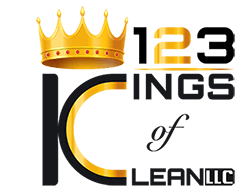
How to Avoid Cross-Contamination: Safety Recommendations
Want to know how to avoid cross-contamination but don’t know what to do? Appropriate measures must be taken in your operation to help prevent this due to repercussions that can be dangerous and costly.
Here, we’ll tell you everything you need to know to keep your home safe from harmful bacteria and viruses.
What Is Cross-Contamination?
Cross-contamination occurs when harmful bacteria or other microorganisms are unconsciously transferred from one surface to another, such as food, utensils, and even our own hands.
Hand-washing is an important step that many of us overlook when preparing a meal. Most cases of cross-contamination can be avoided at home if we follow simple sanitation steps for proper food preparation.
If you want to know how to avoid cross-contamination, continue reading this blog and learning all you need to know to keep your spaces sanitized.
Where It Occurs?
Cross-contamination take place at a large scale due to improperly disinfected equipment. When it comes to cross-contamination, the majority of the cases come from your kitchen equipment. Since your knives and cutting boards are the main culprits in your kitchen, you need to make sure they’re constantly being cleaned and disinfected.

Types of Cross-Contamination
Cross-contamination can be classified into three types:
Biological Contamination

It occurs when harmful bacteria or pathogens are consumed. Biological contamination is the primary cause of foodborne illness and food poisoning as well as a significant contributor to food spoilage and waste.
Among different types of pathogens, four particular types that can contaminate your food.
- Viruses
- Bacteria
- Parasites
- Fungi (mold and yeast)
Certain types of pathogens can produce dangerous toxins in the process of multiplying. In fact, one of the most harmful natural poisons in the world is caused by a bacteria called botulinum.
When consuming contaminated food; can lead to food poisoning or food-borne illness.
Chemical Contamination

It occurs when chemical agents get into food.
Everyday chemicals like sanitizers, polishers, and cleaners can help to prevent cross-contamination. But, when you’re not using them properly it can lead to food poisoning.
Ensure all your chemicals are purchased from reliable suppliers and store food away from prep areas.
Common chemical contamination in a kitchen include:
- Dirty fruits and vegetables: Fungicides and pesticides on fruits and vegetables can be toxic if ingested. Before you start preparing food that includes all your greens, make sure you properly wash them.
- Non-safe plastic: Always store raw food or ready-to-eat food in containers designed for reuse.
- Kitchen appliances and equipment: Your blender slicers and knives may need regular oiling and cleaning to prevent any residues contaminates the food.
Physical Contamination
Physical contamination happens when any physical object finds its way to food. These can include glass, dirt, hair, jewelry, and others.
To prevent this, inspect all the food you receive carefully and make sure everyone handling food is aware of their surroundings.
Which Are Some Ways You Can Prevent Cross-Contamination
There are many ways you can help prevent cross-contamination.
When Shopping
Separate raw meatpoultry, or seafood from other types of food in your shopping cart and storage room. A good tip is always to place them in plastic bags to avoid juices drip onto other food.
When Preparing Food

Hand-washing is an important step we often forget when we cook. We can prevent foodborne illness if we practice simple yet effective proper cleaning steps.
Wash your hands with hot soapy water to keep them clean, and use a paper towel to dry them. This way, you’ll avoid using fabric cloths, which can host a ton of bacteria.
Clean your kitchen surface with a clean cloth or paper towel every time you start preparing food. A good tip is to always wash your fabric cloths in the hot cycle of the washing machine.
Use different cutting boards for fresh produce and raw food. Also, never place cooked food back on the same cutting board where you prepare raw food.

Disinfect Surfaces to Avoid Cross-Contamination
You must constantly be cleaning and sanitizing equipment, utensils, and work surfaces after each use to avoid cross-contamination.
As well, commonly touched items should always be cleaned regularly. Among them, we can find cabinet knobs, refrigerator handles, even our cellphones.
Depending on the situation, you may need some special cleaning supplies and commercial disinfectants.
Products to Prevent Cross-Contamination
Now that you know how to avoid cross-contamination, you should consider including some essential products in your daily kitchen routine that will help create sanitary habits.
- Sterilization with probe wipes is essential for disinfecting probe thermometers.
- Disposable thermometers help eliminate cross-contamination risk.
- Label all your fooditems, so everyone knows what is safe for consumption and what’s being stored.
Use Ultraviolet Light to Kill Bacteria
With great advances in technology, UV light can serve as a supplement to cleaning procedures and help increase the disinfection frequency of hard-to-clean areas of your home or commercial kitchen.
UV light can also be used to replace chemical, harmful disinfectants.
Preventing Foodborne Illness
Foodborne illness occurs when pathogenic or disease-causing microorganisms get into food and multiply to dangerous levels before being consumed.
Bacteria and other pathogens prosper in the following foods:
- Moist
- Neutral in acidity
- High in protein
The best way to avoid foodborne illness is by being aware of the risk of contamination at each stage of the food preparation process. Contaminating food is possible before, during, and after the preparation process.
It is important to you and your employees to be familiarized with products and techniques for preventing cross-contamination. Ensure your spaces are safe and sanitary by implementing cleaning safety protocols to help you identify and control any contamination risk.
Now that you know how to avoid cross-contamination, you must start practicing sanitary habits to keep your spaces clean and virus-free.
If you need help regarding commercial or residential sanitation measures, then you can get in touch with one of our experts, and we will provide you with the assistance you need.
